Products: September 2005
Hardware, Software, Tools, and Utilities
Latest News
August 1, 2005
By DE Editors
Hardware, Software, Tools, and Utilities
One Machine Tool for Turning and MillingTekSoft Inc. (Scottsdale, AZ) has released CAMWorks 2005. Key to this release is the new CAMWorks Mill-Turn module with support for C-, Y-, and B-axis machining. Additionally, the software features numerous productivity enhancements for milling, turning, and wire EDM.
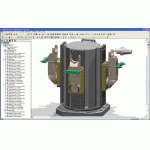
The new CAMWorks Mill-Turn module extends the capabilities of the existing CAMWorks system by providing a programming solution for milling and turning on the same machine tool, with machining cycles available for C-, Y-, and B-axis machining at compound angles and on the face, ID, and OD of a part. Mill and Turn features are identified by automatic feature recognition (AFR) and defined using interactive feature recognition (IFR), which can be used to define 3-axis features for Y-axis milling. For cylindrical features that would be machined by C-axis motion, Mill-Turn includes a new Wrapped feature.
Operations include automatic roughing, finishing, thread milling, and single point cycles plus all advanced 3-axis cycles. All machining operations are defined, calculated, and verified in the SolidWorks environment. CAMWorks integrates seamlessly into SolidWorks 3D mechanical design software.
For complete details, visit teksoft.com.
Blue Ridge Numerics (Charlottesville, VA) has announced CFdesign Version 8.0, its full-featured upfront fluid flow and heat transfer simulation application for design and mechanical engineers who are not pedigreed CFD analysts. Engineers wield CFdesign’s simulation, visualization, and collaboration tools through an interface fully usable by those who are power users of MCAD, LabVIEW, or other design and mechanical engineering tools.
CFdesign has been enhanced in all areas. However, V8.0 offers particular enhancements in six areas: MCAD interoperability, mesh generation, simulation scope, simulation speed, design review, and project collaboration.
V8.0’s interoperability improvements include associative integration with CATIA V5, Inventor, Pro/E, Solid Edge, SolidWorks, and UGS NX. Mesh generation enhancements include real-time mesh size estimator, automated part-by-part meshing, and mesh and analysis export for CAE and CFD applications.
Simulation scope features such as local wall roughness, diffusion coefficient, and low Reynolds Turbulence Model have been added. The Advanced Analysis Module includes expanded Joule Heating model and expanded compressible liquid models. New Design Review features include particle trace resident time, enhanced massed particle traces, nonplanar cutting surfaces, and cutting surface morphing. For project collaboration CFdesign now offers automatic 3D interactive report publishing, annotations of simulations, and portable dynamic image format.
To smooth the analysis process, V8.0’s Automated Solution Center includes both Intelligent Solver Selection and Intelligent Solution Control capabilities that automatically select appropriate solvers from dozens of options. These capabilities also monitor and assess solution convergence during the numerical calculation phase of the simulation and determine when simulation results are complete and reliable.
The V8.0 Motion Module uses process templates, a motion editing station, and kinematics preview window to simplify access of new flow-driven motion analysis capabilities. The V8.0 real-time mesh estimator gives you an idea of memory requirements prior to initiating simulations. This means that it ensures solutions for complex applications when computer capacity is less than optimal.
For complete details and to arrange for an online demo, go to cfdesign.com/v8.
DirectConnect for Pro/Engineer from Alias (Toronto, ONT) lets users efficiently visualize, create, and share photorealistic 3D models for design evaluation and presentation using Alias ImageStudio. A designer can create finished, realistic rendered images within hours of installing ImageStudio. An extensive library of materials and rendering environments puts years of rendering experience at designers’ fingertips.
Alias DirectConnect for Pro/Engineer is built on the PTC GRANITE Interoperability Kernel, enabling Alias ImageStudio to directly import native 3D models from Pro/E. This allows Alias ImageStudio to be easily integrated into companies using Pro/Engineer in their product development process.
For details and a free trial, visit alias.com.
The Electronics Kit CD from Comsol (Burlington, MA) is a free, interactive introduction to multiphysics modeling and simulation using the company’s software, COMSOL Multiphysics (formerly FEMLAB). The CD focuses on multiphysics in the electronics industry; however, the software is suitable for simulation and modeling problems in a variety of engineering and scientific fields.
The Electronics Kit CD is available free of charge. To sign up for it, go to comsol.com/electronics.
Ansoft Designer SV is a free microwave and radio frequency (RF) circuit-design software tool based on the latest commercial version of Ansoft Designer from Ansoft Corporation (Pittsburgh, PA). The software provides students and professionals with an easy-to-use tool for applying basic circuit theories and techniques while developing their high-frequency engineering skills.
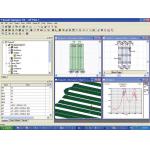 This version of Ansoft Designer SV introduces a new planar electromagnetic solver and a complete high-frequency linear circuit simulator. Other features include proprietary physics-based distributed and discontinuity models; a fully integrated schematic/layout editor; filter and transmission-line synthesis; a Smith Tool matching utility; single database software architecture; a large number of circuit models for lumped, ideal, and physical distributed microstrip, stripline, and coax transmission lines; a full device library; and more.
This version of Ansoft Designer SV introduces a new planar electromagnetic solver and a complete high-frequency linear circuit simulator. Other features include proprietary physics-based distributed and discontinuity models; a fully integrated schematic/layout editor; filter and transmission-line synthesis; a Smith Tool matching utility; single database software architecture; a large number of circuit models for lumped, ideal, and physical distributed microstrip, stripline, and coax transmission lines; a full device library; and more.
Moldflow Corp. (Framingham, MA) announced two enhanced injection molding solutions, Moldflow Plastics Xpert (MPX) 4.0 and Shotscope 4.0. New features in both will help improve manufacturing productivity and efficiency. Both Shotscope and MPX are part of Moldflow’s Manufacturing Solutions offerings.
MPX automates the setup, optimization, and control of the injection molding process. MPX 4.0 helps manufacturers maintain optimal conditions to produce quality parts at low costs. Enhancements include a new viscosity control method that automatically compensates for changes in plastics flow characteristics during production. A new setup routine helps determine an optimum injection velocity from the relative viscosity shear rate curve. MPX 4.0 also interfaces with current machine control technology and provides online process correction technology.
Shotscope is a quality analysis application designed to prevent defective parts from entering the supply chain. New features for Shotscope 4.0 include automatic part diversion after machine downtime, automatic reject counting of auxiliary equipment, and new labor tracking options that allow for swipe card login and multiple operator logon per machine.
For details, visit moldflow.com.
CoolitPCB, a new software package from Daat Research (Hanover, NH), was created to enable PCB designers to perform their own board-level thermal analyses. Engineers now can accurately predict the thermal behavior of their designs and pinpoint optimum component placement on their boards, says Daat, adding that there is no need for expert knowledge of heat transfer or CFD—CoolitPCB’s intelligent user interface steers the user through the solution process. The solution is built around a computational engine that has been successfully used for hundreds of design projects, says the manufacturer.
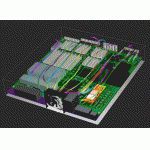
The software features the ability to import board designs from CAD and EDA software and offers performance-testing for standard JEDEC forced, free convection slots as well as custom setups. In addition, the software can report component-junction temperature and case temperature, as well as detailed 3D airflow and temperature distribution.
CoolitPCB is fully integrated with Daat’s flagship thermal design software, Coolit. Price: $3,900 (for a perpetual license). For further information, visit coolitpcb.com.
The Actius AL3D notebook from Sharp Systems of America (Huntington Beach, CA) uses special 3D LCD screen technology for a realistic sense of depth and presence.
The Actius AL3D display switches between 2D and 3D display modes at the touch of a button. The system is powered by the Intel Pentium M Processor 750, the NVIDIA GeForce Go 6600 graphics processor with 128MB Video RAM, and stocked with 1024MB of DDR2 SDRAM. The 3D effect is achieved using a parallax barrier technique, meaning separate light signals from the LCD reach the viewer’s left and right eyes. When centered in front of the display, each eye receives the correct visual information for the brain to process, making it possible for the image on the screen to appear in 3D without special goggles.
The Actius AL3D includes a 15-in. XGA (1024 X 768) LCD screen, and operates with Windows XP Professional. In addition to being able to support 3D software applications, the Actius AL3D comes with an advanced optical drive, making the notebook capable of viewing 3D DVD content. The Actius AL3D comes complete with a DVD Dual Layer Super Multi-Drive with DVD-RAM and CD-R/RW media compatibility.
Price: $3,499. For more information, visit store.sharpsystems.com.
Glacier Computer (New Milford, CT), a developer of industrial computer systems for harsh environments specifically designed for mobile and fixed-mount data collection, has released a new 1,350 nit sunlight-readable LCD enhancement. This feature makes Glacier’s GX 1000A computer easy to read in any environment.
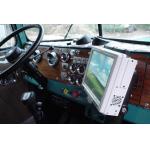 The GX 1000A is a rugged PC-compatible industrial computer typically found on forklifts, dock doors, and manufacturing and shop floors. The introduction of a true sunlight-readable display is expected to broaden the market for the GX 1000A.
The GX 1000A is a rugged PC-compatible industrial computer typically found on forklifts, dock doors, and manufacturing and shop floors. The introduction of a true sunlight-readable display is expected to broaden the market for the GX 1000A.
There are numerous ways to address sunlight readability with varying results. Transflective displays and special coatings are often used in an effort to save costs or battery life on portable devices. The GX 1000A uses four specially developed backlight inverters providing 1,350 nits of brightness. Traditional laptops often run at less than 300 nits and are difficult to read outside during the day.
The GX 1000A is an 800MHz computer with display, touchscreen, and multiple standard I/O ports. The unit is capable of running all Windows operating systems and works with numerous local and wide area wireless networks. GX units can be mounted on vehicles, carts, and in fixed locations.
For more information, visit glaciercomputer.com.
LMS (Leuven, Belgium) has introduced LMS Virtual. Lab Rev 5. This release offers new and completed applications for structural analysis, vehicle ride and handling, interior acoustics simulation, road noise, and durability analysis. Rev 5’s new capabilities automate repetitive tasks and capture complex simulation processes in templates.
The new Auto-Recursive Solver in LMS Virtual.Lab Motion records up to 60% time savings in solving complex simulation models with a long series of linked components and high numbers of contact points between components. This eliminates the calculation bottleneck for the simulation of the dynamic behavior of timing chains, belts, tracked vehicles, complex production machines, etc. To guarantee realistic simulations with high fidelity, Rev 5 also introduces a new LMS Virtual.Lab Correlation module for validating virtual models with test results, or alternatively, with validated models of similar designs.
Virtual.Lab Rev 5’s other new or updated capabilities include new automation and customization options; integrated drivers for such industry-standard solvers as MSC.Nastran, NX Nastran, ANSYS, and ABAQUS; a new module for random vibro-acoustics; a motion capability with solver technologies; and new modeling capabilities to simulate system dynamics.
Dual-Core Opteron-based WhisperStation Handles 64-bit Engineering ApplicationsMicroway (Kingston, MA) is shipping its new WhisperStation workstation to customers looking for quiet while running demanding applications. The standard tower configuration includes a pair of single- or dual-core 64-bit AMD Opteron 275 processors, 16GB of DDR 400 fast memory, one 400GB SATA drive, NVIDIA FX1300 PCI Express Graphics engine, and Viewsonic 20-in. LCD monitor. The system is delivered fully integrated with Linux or Microsoft Windows XP 64-bit Edition, and is designed to drive the latest specialized 64-bit applications.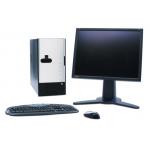
WhisperStation can be customized to include Intel EM64T processors, RAID storage, higher end graphics cards including the Quadro FX4400, memory up to 16GB, and other I/O cards. Applications such as Matlab, OrCAD, amiraMOL modeling software, or performance tools like PathScale EKOPath Compiler Suite and Intel compilers are popular options.
For more information and a subscription to Microway’s online technical newsletter, visit microway.com/whisperstation.html.
Roland Advanced Solutions Division (Lake Forest, CA) announced a new plug-in that enables Rhino users to set up and run Roland 3D laser scanners from Rhinoceros 3D surface modeling software from Robert McNeel & Associates (Seattle, WA).
Rhino 3.0 can create, edit, analyze, and translate NURBS curves, surfaces, and solids in a Windows environment. Rhino 3.0 offers no limits to model complexity, degree, or size. Rhino supports polygon meshes and point clouds.
Roland’s LPX-1200 and LPX-250 3D laser scanners handle a variety of mainstream MCAD and CAM applications. These versatile scanners can, for example, scan a mobile telephone to design blister packaging and/or accessories. They are equally suitable for scanning an ear canal mold for custom-fitted hearing-aid manufacturing. The LPX-1200 has a scanning resolution of 0.0039 in., while the LPX-250 scans objects up to 0.008 in.
Free of charge, the Rhino 3D plug-in comes bundled with both Roland LPX-250 and LPX-1200 3D laser scanners. Rhinoceros 3D can also be downloaded at rolanddga.com.
Golden Software Inc. (Golden, CO) has upgraded its Grapher 2D and 3D graphing package by including contour and 3D surface plots. According to Golden, Grapher 6 users can create contours or a 3D surface using data from any x,y,z data file, an existing Surfer grid file, or a USGS DEM file. Users can color-fill the plots, overlay contours on surface plots, or combine them with other graph types to present their 3D data.
Two other powerful upgrades to Grapher 6 are the ability to automatically create and display variable confidence intervals on line/scatter plots and to create 2D vector plots. All told, Grapher 6 contains more than 100 new features and enhancements.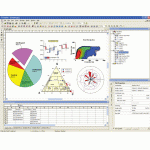
Compatible with other software, Grapher 6 imports and exports data files in all popular formats, and its functionality can be integrated with any ActiveX Automation-compatible software, says Golden Software. Visual Basic, C++, and Perl scripts can be used to call Grapher to automate repetitive functions.
Price: $299; upgrades from previous Grapher versions, $99. For details, visit goldensoftware.com.
Softcover (Cambridge, England) has added thresholding technology to Scan2CAD V7.3, the latest version of the company’s raster-to-vector converter. Thresholding is said to improve the sharpness of your scanned images by dynamically separating the foreground detail from colored, tinted, and dirty backgrounds.
Scan2CAD converts scanned technical drawings into DXF vector files for editing in many MCAD programs. According to the company, by applying Scan2CAD’s thresholding to color or grayscale scans, you can improve your chance of producing a useful conversion by first removing unnecessary background noise and sharpening the essential drawing detail.
Other new features in Scan2CAD V7.3 are a wide-format scanner interface; a dedicated driver to support image acquisition from the Colortrac SmartLF wide-format scanner; single mouse click drawing rotation (Deskew); new icons; and several improved commands.
With the release of Mathematica 5.2, Wolfram Research (Champaign, IL) brings 64-bit technology to all supported platforms. More than 4.3GB of memory (the 32-bit address limit) can now be addressed, and high-precision or large numbers are processed in 64-bit rather than 32-bit digit chunks for faster computation.
Mathematica 5.2 also supports automatically threaded numerical linear algebra on all mainstream platforms, enabling linear algebra operations to automatically run in parallel on all available processor cores whether multiple or multicore CPUs. Mainstream multicore-based systems are now available, including in notebooks and entry-level systems.
Some of Mathematica 5.2’s other enhancements include 64-bit arbitrary-precision numerics; automatic binary installation selection; bundled notebook indexing for desktop search; vCard and RSS import of new algorithms for symbolic differential equations; singular-case support for high-level special functions; MathematicaMark 5.2 benchmark covering grids and clusters; and more.
Mathematica 5.2 is available for Windows (32-bit/64-bit), Mac OS X (32-bit/64-bit), Linux (32-bit/64-bit) as well as such workstation and server platforms as Linux (Itanium), Solaris (x86-64, SPARC), HP Tru64 Unix, HP-UX, IBM AIX, SGI IRIX, and compatible systems.
Price: $1,880 (includes one year of Premier Service). More details about Mathematica 5.2 can be found at wolfram.com/mathematica.
Laser Design (Minneapolis, MN) has introduced what it says is the industry’s fastest laser scanning probe on an articulated arm, providing “a 33 percent-50 percent reduction in scanning time on any complex part.”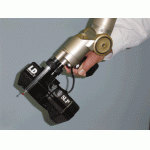
The company’s new SLP-330 scanning laser probe is designed for use with the Romer CimCore Infinite, 3000i, and Stinger II portable CMM articulating arms. The unit is designed to enable the scanning of parts with dimensions as long as 12 feet without moving the base of the arm—or of any size if the arm’s base is movable. The unit’s dual detectors view the laser line from two different angles, reducing the number of scanning passes required to capture steep sidewalls and deep geometries.
Depending on the application, the SLP-330 probe is said to capture up to 50,000 points per second. The unit weighs less than a pound.
Laser Design’s scanning packages are also offered with Raindrop Geomagic Studio software that develops CAD models directly from 3D scan data, or it can provide inspection reports from its Qualify inspection software. Geomagic is also designed to fill in missing data from areas that are difficult to access.
GibbsCAM 2005 V7.7 Now Shipping
Gibbs and Associates (Moorpark, CA) is shipping GibbsCAM 2005 V7.7 to GibbsCAM Maintenance users. This latest release of GibbsCAM offers more than 300 enhancements and fixes requested by end-users and resellers, says the company. GibbsCAM 2005 also includes a number of enhancements that ensure compatibility with the latest versions of CATIA, Inventor, Pro/E, Solid Edge, SolidWorks, and UGS NX.
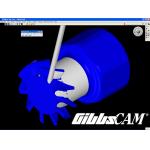
Some key enhancements include full system documentation for all modules in Adobe Acrobat PDF format; a feed/speed optimizer that allows process variables to be globally adjusted; basic lathe utility ops to support non-cutting operations; and the integration of Charmilles CT-Expert into GibbsCAM Wire-EDM.
GibbsCAM 2005 also introduces ProAXYZ from Productec, a new module that supports 4-axis simultaneous machining of radially prismatic parts and off-center Y-axis cutting, expanding GibbsCAM’s 4- and 5-axis machining capabilities.
More information on GibbsCAM 2005 is available at gibbscam.com.
The OM-CP-RFRTDTEMP101A is a battery-powered precision temperature recorder and wireless transmitter from Omega Engineering (Stamford, CT). According to Omega, this all-in-one compact, portable device can measure and record up to 5,461 measurements.
The OM-CP-RFRTDTEMP101A features a wireless transmitter that can transmit readings back to a host computer where the data can be analyzed in real time. Readings are also logged to the device’s memory for added data security. A slide switch allows the transmitter to be turned on or off without affecting the operation of the device. The device can be started, stopped, and configured directly from your computer, and its small size allows it to fit almost anywhere.
Data from the device can be retrieved by plugging it into a COM port and letting the bundled software handle the rest.
Price: $449. For more details, visit omega.com.
Subscribe to our FREE magazine, FREE email newsletters or both!
Latest News
About the Author
DE’s editors contribute news and new product announcements to Digital Engineering.
Press releases may be sent to them via [email protected].






